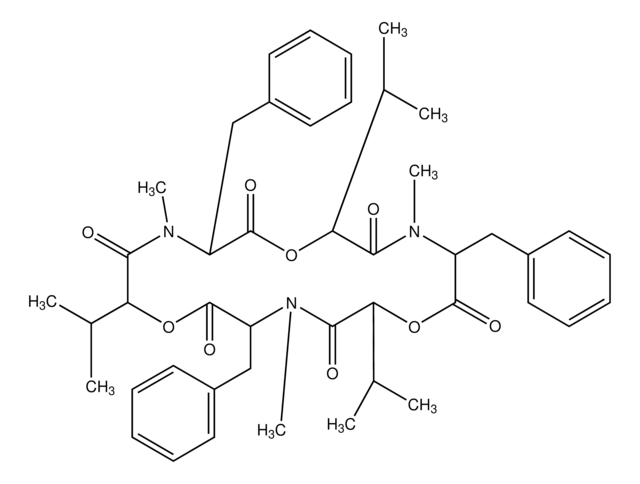M5269
Moniliformin sodium salt from Fusarium proliferatum
Synonym(s):
1-Hydroxycyclobut-1-ene-3,4-dione
Sign Into View Organizational & Contract Pricing
All Photos(1)
About This Item
Linear Formula:
C4HO3Na
CAS Number:
Molecular Weight:
120.04
MDL number:
UNSPSC Code:
12352200
PubChem Substance ID:
NACRES:
NA.77
Recommended Products
Quality Level
storage temp.
2-8°C
SMILES string
O=C1C(C=C1[O-])=O.[Na+]
InChI
1S/C4H2O3.Na/c5-2-1-3(6)4(2)7;/h1,5H;/q;+1/p-1
InChI key
FERDNJVXTWPNSA-UHFFFAOYSA-M
General description
Moniliformin (MON), a mycotoxin and small ionic molecule, is present in various Fusarium species including Fusarium avenaceum, Fusarium subglutinans and Fusarium proliferatum. It is present as sodium or potassium salt of semisquaric acid naturally. MON is also present in maize and small-grain cereals.
Application
Moniliformin sodium salt from Fusarium proliferatum has been used as a mycotoxin standard:
- to test its acute oral toxicity in mice
- to test its subacute toxic effects in rats
- in characterizing mycotoxins from Aspergillus
Biochem/physiol Actions
Moniliformin (MON) is implicated for its toxic potential and may lead to respiratory distress and progressive muscular weakness in rats. It inhibits the tricarboxylic acid (TCA) cycle oxidation step. By acting as a pyruvate substrate, MON effectively inhibits thiamine pyrophosphate cofactor dependant enzymes and blocks the gluconeogenesis pathway. ) Furthermore, MON also inhibits glutathione peroxidase and glutathione reductase leading to oxidative stress in myoblast.
Signal Word
Danger
Hazard Statements
Precautionary Statements
Hazard Classifications
Acute Tox. 3 Oral
Storage Class Code
6.1A - Combustible acute toxic Cat. 1 and 2 / very toxic hazardous materials
WGK
WGK 3
Flash Point(F)
Not applicable
Flash Point(C)
Not applicable
Personal Protective Equipment
dust mask type N95 (US), Eyeshields, Gloves
Certificates of Analysis (COA)
Search for Certificates of Analysis (COA) by entering the products Lot/Batch Number. Lot and Batch Numbers can be found on a product’s label following the words ‘Lot’ or ‘Batch’.
Already Own This Product?
Find documentation for the products that you have recently purchased in the Document Library.
Customers Also Viewed
An Zhang et al.
Journal of Zhejiang University. Science. B, 11(3), 200-208 (2010-03-06)
To investigate the effects of mycotoxin moniliformin (MON) on the metabolism of aggrecan and type II collagen in human chondrocytes in vitro and the relationship between MON and Kashin-Beck disease (KBD). Human chondrocytes were isolated and cultured on bone matrix
Katharina Walburga von Bargen et al.
Journal of agricultural and food chemistry, 60(14), 3586-3591 (2012-03-21)
Moniliformin is a mycotoxin produced by fungi of the Fusarium genus and occurs as a contaminant of different cereals worldwide. This study describes the first application of isotopically labeled (13)C(2)-moniliformin for the analysis of moniliformin in cereals. Moniliformin is a
H R Burmeister et al.
Applied and environmental microbiology, 37(1), 11-13 (1979-01-01)
Fusarium moniliforme NRRL 6322 produced about 600 mg of recoverable moniliformin, a mycotoxic metabolite, per kg of corn grit medium. The moniliformin was extracted from the grits with methanol, purified by preparative thin-layer chromatography, and crystallized from ether. The 50%
Martina Jonsson et al.
Toxicology letters, 233(1), 38-44 (2014-12-09)
Moniliformin is a Fusarium mycotoxin mainly produced by several species infecting grains in different climatic conditions. According to our previous studies, it is acutely toxic to rats, with an LD50 cut-off value of 25mg/kg b.w. To further assess the possible
A Waskiewicz et al.
Food additives & contaminants. Part A, Chemistry, analysis, control, exposure & risk assessment, 27(5), 608-615 (2010-05-11)
The principal aim of this study was to estimate the formation of fumonisins (FB(1) and FB(2)), moniliformin (MON), and ergosterol (ERG) by Fusarium oxysporum and Fusarium proliferatum, while the formation of beauvericin (BEA) was estimated by the latter Fusarium species
Our team of scientists has experience in all areas of research including Life Science, Material Science, Chemical Synthesis, Chromatography, Analytical and many others.
Contact Technical Service









